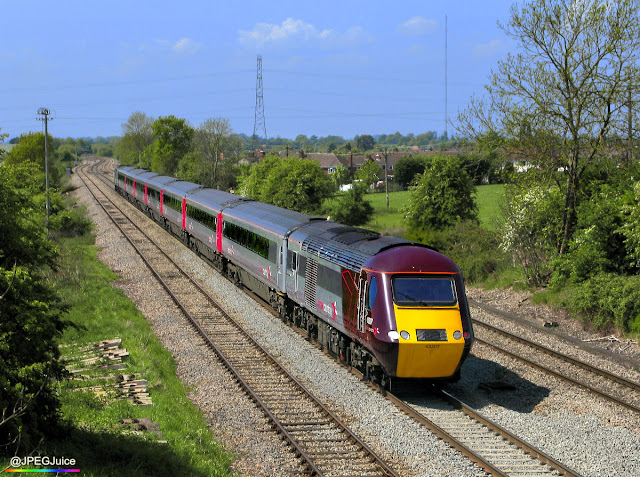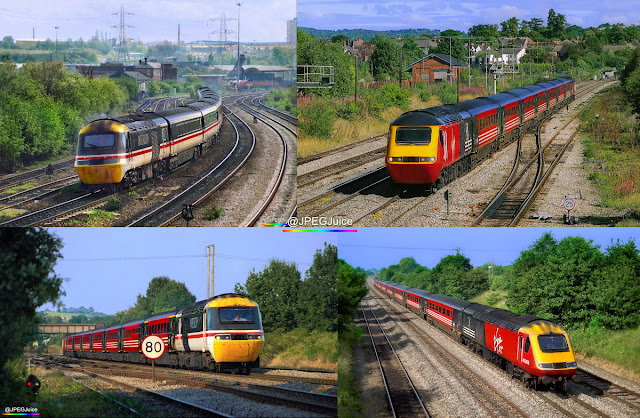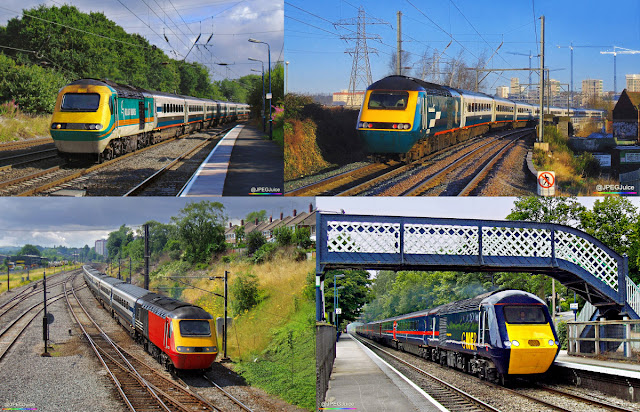"...All but one had been Virgin CrossCountry power cars before the introduction of the Voyagers, and so were really just returning to old haunts."

In 2003, when Virgin Trains announced that their use of HSTs on CrossCountry had come to an end, it looked as though more than two decades of regular IC125 service over the network had passed into history for good.
Demand for the 1970s design icons did, however, persist, and for the next few years Virgin drafted in HSTs on short-term hire to extend capacity when required. But when Arriva won the new CrossCountry franchise in summer 2007, they pledged that the HST would return to daily operation on XC routes. A new era was about to begin for the vintage-yet-still-modern classic. MTU-engined Class 43s in the distinctive late noughties XC livery would become a familiar sight, and remain so for over a decade…
BACKGROUND

CrossCountry HSTs in the British Rail era.
The use of HSTs on CrossCountry routes began at scale in May 1982, when British Rail deployed its then futuristic 125s on many North East – South West services. Only a year earlier, these services had not only been loco-hauled – they’d still in fact been steam-heated. In September 1981, the regime of steam-boilered Class 45/0s, 46s and 47/0s finally gave way to 45/1s and 47/4s with electric train supply. And while, by mid ’82, some steam-heated services remained, the core template for the next two decades had been set. You can find a pictorial exploring CrossCountry in BR days in The History of InterCity livery on CrossCountry Trains.
The combination of HSTs and electrically-heated, loco-hauled services would survive into the Virgin Trains era, and the next century.

CrossCountry HSTs in the Virgin era.
Virgin Trains adopted CrossCountry in January 1997, pledging to replace the trains they’d inherited from British Rail. Traffic still remained broadly the same until late 2001, with over twenty HST sets working daily diagrams. The loco-haulage became a lot less prone to odd stand-ins as Virgin progressively gained access to additional Class 47s through the likes of Fragonset and EWS. But other than that, in summer 2001 CrossCountry was still basically the late ’80s BR InterCity scene in a red and charcoal suit. This period is covered in the Virgin Trains HSTs post.
The change, however, was about to come, and its impact would be swift. Rapid introduction of Voyager units between 2001 and 2002 meant that there was no significant “stay of execution” for the HSTs beyond the demise of Class 47-hauled services. Some enthusiasts had imagined that the withdrawal of ex-BR power would be staged. But while the Class 47-hauled services were a higher priority target for elimination, circumstances enabled Virgin to blitz the HST schedule almost immediately after they dumped loco-haulage.
The daily loco-hauled schedule officially ended on CrossCountry in mid August 2002. And the following month, Virgin sought to revolutionise CrossCountry with Operation Princess – a programme designed around the Voyager’s shorter length and greater prolifery.
Before Operation Princess, although Virgin’s Voyagers had been delivered thick and fast, they’d been working in pairs. That had limited the number of diagrams they could cover. But when the Voyagers were split to work individually within the new programme, the number of separate trains available for use suddenly and dramatically increased. Even though there were now more diagrams to fulfil, the splitting of the Voyagers had an instant impact on the visible profile of the Virgin HST. The operator immediately began handing off Class 43s to other TOCs.
Remaining HST stock was reconstituted, creating shorter consists which would essentially play the role of Voyagers on CrossCountry, and steadily orientating the remaining fleet towards West Coast duties. From autumn 2002, the Virgin HST retained only 6 booked CrossCountry diagrams, with 24 x 7-car CrossCountry sets reduced down to just 11 x 5-car sets (8 of which were required the cover the booked workings). Initially, there were also 6 x additional 5-car sets held on standby to dep for unavailable Voyagers. At the end of summer 2003, Virgin XC announced its cessation of HST use.
THE “DARK” YEARS

De-branded Virgin power car 43153 tails a set led by 43098 on one of the summer 2004 holiday trains. Full ‘Kit-Kat’ liveried HSTs were by this time celebrities.
In 2004, Virgin did still have some HSTs. It just didn’t have any scheduled use for them on CrossCountry until the summer, when they were tasked with holiday trains – still in Virgin livery but now without the branding. Since the active Virgin survivors by that time only comprised a handful of power cars, GNER sets were hired in to supplement them. There was also some summer loco-haulage on CrossCountry in 2004, although the trains were hauled by Class 67s – not 47s.
It should additionally be noted that branded Virgin HSTs did stray onto the CrossCountry network after the September 2003 cut-off, and through into the first half of 2004, after which West Coast also concluded its use of HSTs and there was no longer a branded fleet.
By 2005, the Virgin HST, as such, was no longer a thing, but the need for extended capacity on CrossCountry forced Virgin to hire Midland Mainline and GNER sets for summer holiday trains. Enough HST stock was available by 2005 to completely eliminate loco-haulage from the XC summer Saturday schedule. It was also possible, on occasion, for Virgin to cover a proposed HST run with a double Voyager.

Hired HSTs working for Virgin between 2005 and 2007. The de-branded Virgin red power car is 43157, which later returned as a CrossCountry mainstay in the guise of 43357.
2006 and 2007 essentially saw repeat performances of the summer 2005 practices. Midland Mainline and GNER HSTs making up the shortfall in Virgin Voyagers when capacity was stretched. I've covered the mid 2000s HST-powered holiday trains with more photographs in HSTs in the West Midlands and Worcestershire: 1999 - 2009.
THE ARRIVA FRANCHISE

Power car 43166 in the initial phase of CrossCountry HST re-introduction (spring to summer 2008), during which half of the ten selected power cars operated in unrefurbished, Paxman-engined form whilst refurbishment of the other half commenced. 43007 is at the rear of this full Rio-liveried set.
The Arriva CrossCountry franchise went live in November 2007, but HSTs would not be (re)introduced for another six months. The long-term plan was to use refurbished sets, with the replacement MTU engines which had already been fitted to the majority of Great Western power cars and some East Coast examples.
However, no CrossCountry HST refurbishments had been completed by May 2008 when scheduled duties began, so initially, five power cars ran with their old Paxman engines, in de-branded Midland Mainline ocean blue – most often known as Rio livery. No refurbished CrossCountry rolling stock was available upon introduction either, so the coach sets initially comprised de-branded MML vehicles.
Ten power cars were selected for use with Arriva XC. While, in the majority of cases, their most recent duties had been with Midland Mainline, all but one had been Virgin CrossCountry power cars before the introduction of the Voyagers, and so were really just returning to old haunts. The exception – 43085 – had been one of the original Midland Mainline power cars in the late 1990s.
Since, due to the start of the refurbishment programme, there were only two full XC sets in use at the start of July 2008, HSTs were once again hired in for summer Saturday holiday trains – this time from National Express East Coast.

National Express East Coast’s 43239 providing cover for Arriva CrossCountry in the summer of 2008.
In summer 2008, both National Express and re-branded GNER liveries could be seen on the hired sets, while mixes of Midland Mainline and the then new CrossCountry livery could be found on the native sets. It was briefly common to find CrossCountry HSTs with a Paxman-engined MML power car at one end, and an MTU-engined XC at the other.
There then followed another brief phase in which the typical set would have an MTU-engined XC power car at both ends of a full MML stock set. Through the transition, there were no mixtures of coaching stock as there had been with Virgin, or during BR days. It was either a full MML set or, progressively from October 2008, a full CrossCountry set.
THE ACTUAL POWER CARS
In this final section of the article, I’m going to document the source of the ten selected power cars for ‘New CrossCountry’, and provide an illustration of each power car. The summary text starts with each power car as it was at the beginning of the re-introduction programme, but for variety, the illustrations show the power cars at various points in post-BR CrossCountry service…

43007 – De-branded Midland Mainline Rio livery. Worked Arriva XC services in this guise until August 2008. Returned to service with MTU engine as 43207 in December 2008.

43085 – Ex-Midland Mainline. Assigned for refurbishment in autumn 2007, so no Arriva service as 43085. Introduced to Arriva XC with MTU engine as 43285 in August 2008.

43101 – Ex-Virgin Trains. Had been in store at Loughborough since March 2004, in plain black livery with Virgin red cab, after rejection from the New Measurement Train (NMT) project due to prohibitive repair costs. So no Arriva service as 43101. Introduced to Arriva XC with MTU engine as 43301 in July 2008.

43103 – Ex-Virgin Trains. Was in store at Long Marston in de-branded Virgin livery. Briefly earmarked as part of a temp replacement for Hull Trains’ damaged 222103 in spring 2007, but after a change of plan, instead set aside for CrossCountry in July 2007 and sent for refurbishment. No Arriva service as 43103. Introduced to Arriva XC with MTU engine as 43303 in July 2008.

43104 – De-branded Midland Mainline Rio livery. Worked Arriva XC services in this guise until August 2008. Returned to service with MTU engine as 43304 in December 2008.

43121 – Ex-Virgin Trains. Was in store at Long Marston in de-branded Virgin livery. Briefly earmarked as part of the temp replacement for Hull Trains’ damaged 222103 in spring 2007, but like 43103, diverted into the CrossCountry allocation instead. Sent for refurb in January 2008, so no Arriva service as 43121. Introduced to Arriva XC with MTU engine as 43321 in September 2008.

43157 – Ex-Virgin/MML. Had worked Midland Mainline services in de-branded Virgin livery before refurbishment (and notably been re-hired by Virgin for holiday trains during that time). Assigned for MTU upgrade in February 2008, so no Arriva service as 43157. Introduced to Arriva XC with MTU engine as 43357 in September 2008.

43166 – De-branded Midland Mainline Rio livery. Worked Arriva XC services in this guise until September 2008. Returned to service with MTU engine as 43366 in January 2009.

43178 – De-branded Midland Mainline Rio livery. Worked Arriva XC services in this guise until July 2008. Returned to service with MTU engine as 43378 in November 2008.

43184 – De-branded Midland Mainline Rio livery. Worked Arriva XC services in this guise until July 2008. Returned to service with MTU engine as 43384 in November 2008.